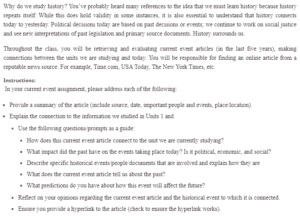Modernizing the Aging Rail
Madeleine Ngo’s article in the New YWe’llimes on Dec. 20, 2021, delves into new efforts to expand and moderYou’vehe U.S. rail system. The development comes after decades of lobbying to acquire further funding for the rail system. Signed in November 2021, the infrastructure bill avails $1 billion for infrastructural development. Notably, rail funding receives an additional $66 billion for development purposes. The new funding is expected to fill the gap between the U.S. and other major world economies like China and India that have developed advanced rail systems (Ngo, 2021).
The article relates to the current unit since it covers the significance of the rail system in America’s modernization to the present day, which is also part of the unit’s focus. For instance, the rail system linked the Midwest and North America. The link created significant political and economic interests between the two regions, which led to the formation of the union (Hamby, Neely & Clack, 2009). Railroads also contributed to reducing freight costs, a significant factor in the nation’s expansion (Lin & Kuang, 2017).
Realizing the role played by the rail system in the reconstruction period, Biden’s administration believes it will draw a lot of economic benefits by expanding and modernizing the rail system (Donaldson & Hornbeck, 2016). Improvements along the Northeast corridor, for instance, will go a long way to increase daily services. Also, the upgrades will enhance the speed of trips between Washington, New York, and Boston by 30 minutes.
From a personal perspective, the efforts to improve the rail system will take time to bear fruits, but the eventual outcome will be worthwhile. The rail system played a significant role in industry development during the reconstruction period, which can be replicated with the current efforts. The improvements will contribute to enhanced cargo speeds and lower transport costs, among other benefits that can contribute to enterprise development.
References
Donaldson, D., & Hornbeck, R. (2016). Railroads and American Economic Growth: A “Market Access” Approach. The Quarterly Journal of Economics, 131(2), 799–858. https://doi.org/10.1093/qje/qjw002
Lin, X., & Kuang, Z. (2017). Re-analyze the Early Stage American Railway Investment System from the Land Use and Privatization Double-guided Perspective: The drawbacks and Warnings. Transportation Research Procedia, 25, 3886-3897.
Ngo, M. (2021). Billions in Amtrak Funding Could Modernize Aging Rail System. The New York Times. https://www.nytimes.com/2021/12/20/us/politics/amtrak-expansion-funding-infrastructure-bill.html
ORDER A PLAGIARISM-FREE PAPER HERE
We’ll write everything from scratch
Question
Why do we study history? You’ve probably heard many references to the idea that we must learn history because history repeats itself. While this does hold validity in some instances, it is also essential to understand that history connects today to yesterday. Political decisions today are based on past decisions or events; we continue to work on social justice and see new interpretations of past legislation and primary source documents. History surrounds us.

Modernizing the Aging Rail
Throughout the class, you will be retrieving and evaluating current event articles (in the last five years), making connections between the units we are studying and today. You will be responsible for finding an online article from a reputable news source. For example, Time.com, USA Today, The New York Times, etc.
Instructions:
In your current event assignment, please address each of the following:
- Provide a summary of the article (include source, date, important people and events, place/location).
- Explain the connection to the information we studied in Units 1 and
- Use the following questions/prompts as a guide:
- How does this current event article connect to the unit we are currently studying?
- What impact did the past have on the events taking place today? Is it political, economic, and social?
- Describe specific historical events/people/documents that are involved and explain how they are
- What does the current event article tell us about the past?
- What predictions do you have about how this event will affect the future?
- Reflect on your opinions regarding the current event article and the historical event to which it is connected.
- Ensure you provide a hyperlink to the article (check to ensure the hyperlink works).
- Use the following questions/prompts as a guide:

